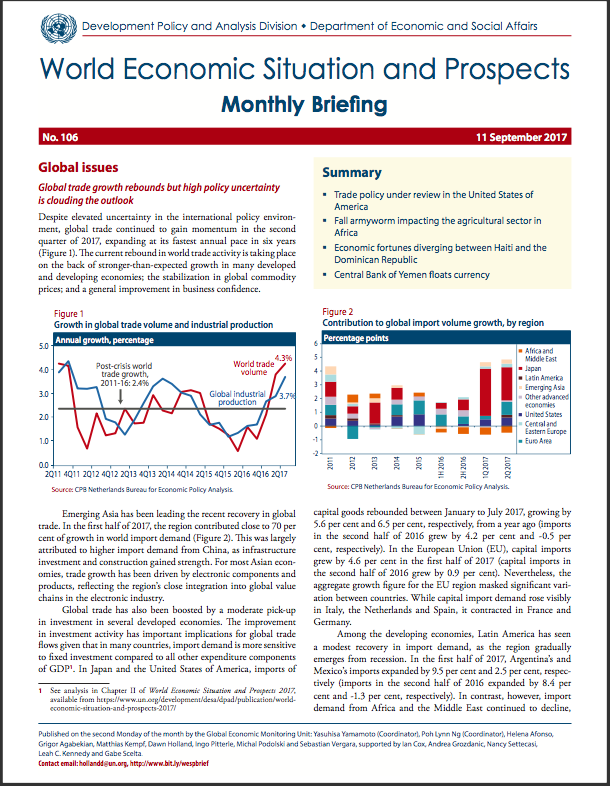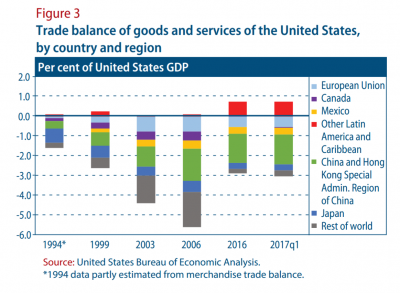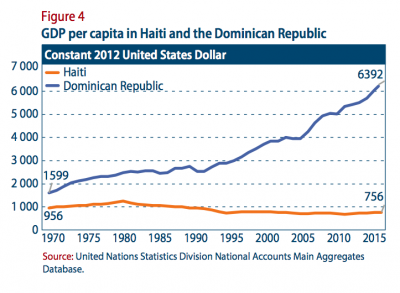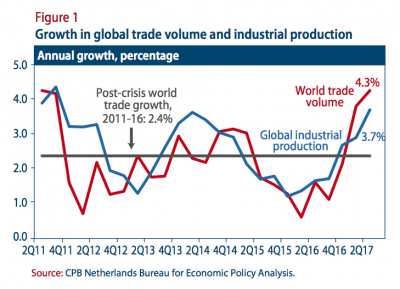
World Economic Situation And Prospects: September 2017 Briefing, No. 106
- Trade policy under review in the United States of America
- Fall armyworm impacting the agricultural sector in Africa
- Economic fortunes diverging between Haiti and the Dominican Republic
- Central Bank of Yemen floats currency
Global issues
Global trade growth rebounds but high policy uncertainty is clouding the outlook
Despite elevated uncertainty in the international policy environment, global trade continued to gain momentum in the second quarter of 2017, expanding at its fastest annual pace in six years (Figure 1). The current rebound in world trade activity is taking place on the back of stronger-than-expected growth in many developed and developing economies, the stabilization in global commodity prices, and a general improvement in business confidence.
Emerging Asia has been leading the recent recovery in global trade. In the first half of 2017, the region contributed close to 70 per cent of growth in world import demand (Figure 2). This was largely attributed to higher import demand from China, as infrastructure investment and construction gained strength. For most Asian economies, trade growth has been driven by electronic components and products, reflecting the region’s close integration into global value chains in the electronic industry.
Among the developing economies, Latin America has seen a modest recovery in import demand, as the region gradually emerges from recession. In the first half of 2017, Argentina’s and Mexico’s imports expanded by 9.5 per cent and 2.5 per cent, respectively (imports in the second half of 2016 expanded by 8.4 per cent and -1.3 per cent, respectively). In contrast, however, import demand from Africa and the Middle East continued to decline, reflecting the persistent weakness in commodity-related revenue, depreciated domestic currencies and subdued investment activity. Notably, investment prospects remain subdued in countries such as Algeria, Saudi Arabia and the United Arab Emirates, amid cuts to oil production and fiscal consolidation efforts. In South Africa, machinery imports recovered from the sharp collapse of -14 per cent seen in 2016 to grow at a modest pace of 3.9 per cent in the first half of 2017. Nevertheless, investment activity in the economy remains affected by political uncertainty, which weighs on investor confidence.Global trade has also been boosted by a moderate pick-up in investment in several developed economies. The improvement in investment activity has important implications for global trade flows given that in many countries, import demand is more sensitive to fixed investment compared to all other expenditure components of GDP[1]. In Japan and the United States of America, imports of capital goods rebounded between January to July 2017, growing by 5.6 per cent and 6.5 per cent, respectively, from a year ago (imports in the second half of 2016 grew by 4.2 per cent and -0.5 per cent, respectively). In the European Union (EU), capital imports grew by 4.6 per cent in the first half of 2017 (capital imports in the second half of 2016 grew by 0.9 per cent). Nevertheless, the aggregate growth figure for the EU region masked significant variation between countries. While capital import demand rose visibly in Italy, the Netherlands and Spain, it contracted in France and Germany.
 Leading indicators, including the Purchasing Managers’ Indices and export orders, are pointing towards continued positive trade growth in the near term. However, the momentum is likely to moderate in the second half of the year, due to a waning base effect[2]. Furthermore, the international trade outlook continues to be clouded by elevated risks in the external environment, particularly the possibility of more restrictive trade policies by the United States. In addition, uncertainty surrounding the United Kingdom’s negotiations as it prepares to leave the EU could weigh on business confidence and affect investment prospects in Europe. Should the growth in large emerging economies - including China - moderate more sharply than expected, the rebound in global trade could relapse.
Leading indicators, including the Purchasing Managers’ Indices and export orders, are pointing towards continued positive trade growth in the near term. However, the momentum is likely to moderate in the second half of the year, due to a waning base effect[2]. Furthermore, the international trade outlook continues to be clouded by elevated risks in the external environment, particularly the possibility of more restrictive trade policies by the United States. In addition, uncertainty surrounding the United Kingdom’s negotiations as it prepares to leave the EU could weigh on business confidence and affect investment prospects in Europe. Should the growth in large emerging economies - including China - moderate more sharply than expected, the rebound in global trade could relapse.
Developed economies
Review of trade policy in the United States
The Government of the United States initiated a sweeping review of existing trade deals in January 2017. Within the first few days of the new Administration, the United States withdrew from the Trans-Pacific Partnership (TPP)[3], stating a preference for bilateral trade negotiations over plurilateral agreements. In May 2017, the Administration notified Congress of its intent to renegotiate the North American Free Trade Agreement (NAFTA), which has governed trade relations between Canada, Mexico and the United States since 1994.
The Office of the United States Trade Representative released a Summary of Objectives[4] for the NAFTA Renegotiation on 17 July 2017, prior to the onset of negotiations in August. The document argues that while some Americans have benefited from the new market access afforded by NAFTA, especially in the agriculture sector, trade deficits have exploded, and other Americans have lost their jobs as production processes relocated abroad. One of the specific objectives highlighted in the document is to “improve the U.S. trade balance and reduce the trade deficit with the NAFTA countries”.
The current account deficit of the United States widened from 1.7 per cent of GDP in 1994 to reach a peak of 5.8 per cent of GDP in 2006, reflecting a build-up of private sector debt as the economy consumed in excess of its domestic production. Since the global financial crisis of 2008-2009, the external deficit of the United States has narrowed significantly, and the current account deficit stood at 2.5 per cent of GDP in the first quarter of 2017. Figure 3 illustrates the trade balance of goods and services by area, which shows that the bulk of this improvement is attributable to narrowing deficits against oil-exporting countries in Africa, South America and Western Asia. The trade balance with Canada was roughly balanced at the start of 2017, with a deficit of 0.3-0.4 per cent of United States GDP against Mexico. Merchandise trade deficits with Canada and Mexico are larger than total trade deficits, reflecting the dominant role of the United States in services trade. This suggests that the United States would clearly benefit from a broader coverage of services in any renegotiated trade deals.
 In addition to the withdrawal from TPP and the review of NAFTA, the United States also initiated an investigation into China’s laws, policies, and practices that may impact exports from the United States. Updating and amending existing trade agreements have the potential to benefit all parties, especially in areas such as transparency in regulation and rules of origin determination, and bringing labour and environmental provisions to the core of the agreements. However, there is a risk that excessive focus on bilateral trade balances may lead to the introduction of new trade barriers, severely disrupting the intricate cross-border production chains that have evolved under existing agreements.[5]
In addition to the withdrawal from TPP and the review of NAFTA, the United States also initiated an investigation into China’s laws, policies, and practices that may impact exports from the United States. Updating and amending existing trade agreements have the potential to benefit all parties, especially in areas such as transparency in regulation and rules of origin determination, and bringing labour and environmental provisions to the core of the agreements. However, there is a risk that excessive focus on bilateral trade balances may lead to the introduction of new trade barriers, severely disrupting the intricate cross-border production chains that have evolved under existing agreements.[5]
Economies in transition
Commonwealth of Independent States: Banking systems in the region still under pressure
According to preliminary data, the Russian economy expanded by 2.5 per cent in the second quarter relative to a year earlier. The strong performance of the construction and industrial sectors offset the weakness in the agricultural sector. The accompanying faster-than-anticipated growth in fiscal revenue prompted the finance ministry to cut its budget deficit projection to 2.1 per cent of GDP from the previous estimate of 3.2 per cent. However, year-on-year GDP growth in July was estimated at only 1.5 per cent. Despite strong inflationary expectations, inflation in the Russian Federation slowed to 3.9 per cent in July, which is below the target of the central bank, and is estimated to have declined further to 3.3 per cent in August due to the late, but ample harvest. This should allow for further relaxation of monetary policy. Inflation is moderating in other economies in the Commonwealth of Independent States (CIS) as well, falling to 6 per cent in Belarus in August, mainly owing to the stronger currency. In response, the National Bank of Belarus announced its seventh policy rate cut in 2017, effective from mid-September. In August, key policy rates were also reduced in Kazakhstan, by 25 basis points to 10.25 per cent, and in the Republic of Moldova, from 8 to 7.5 per cent.
Meanwhile, banking sectors in the CIS still remain under pressure. Many problems they face originated during the recession in 2009, and have been further aggravated by the oil price decline observed in 2014. In August, the National Bank of Kazakhstan announced that it would provide around $3 billion to recapitalize selected commercial banks and facilitate writing off distressed assets, in order to bolster banking sector stability. In the Russian Federation, the central bank took over the largest commercial bank in August, due to a run on its deposits; around $6.9 billion may be needed for its recapitalization.
In early September, the Central Bank of Uzbekistan ended support of the official exchange rate and allowed the currency to float freely. As a result, the currency lost about 50 per cent of its value against the dollar and the official and grey-market exchange rates mostly converged. The restriction on foreign currency operation for businesses and individuals was also relaxed.
In South-Eastern Europe, growth in Serbia remained weak in the second quarter, reaching only 1.3 per cent, as drought has led to a poor agricultural performance.
Developing economies
Africa: The fall armyworm impacting the agricultural sector
The fall armyworm (FAW), a highly invasive pest native to the Americas, has quickly spread over sub-Saharan Africa since it was first discovered on the continent in early 2016. The FAW infests mainly maize, one of the staples in Africa, and can potentially affect 80 other crops, including rice and sorghum. While the region is recovering from the drought in the 2015/16 crop season, the infestation of FAW appears to pose a significant threat to the agricultural sector in Africa. The damage of the FAW has been witnessed at varying degrees over sub-Saharan Africa. The situation is particularly worrisome in countries, such as South Sudan, where weak institutional infrastructure and fragile macroeconomic conditions could prevent effective implementation of mitigating efforts. Local news of several African countries have already cited cases where smallholder farmers have suffered significant economic losses from the FAW invasion.
The FAW infestation has disproportionately large implications for the poorest countries in Africa, where agricultural production constitutes an important part of the economy. In many of these countries, production depends on traditional methods such as rain-fed maize farming. The FAW is known to have natural enemies, but the use of pesticides is the primary method to cope with the infestation, a practice that has been well established and applied for decades in the Americas. Nevertheless, establishing and implementing the FAW pest control is financially challenging in African countries. Failure to effectively implement pest control may negatively impact not only agricultural production and food security, but also the business climate. The threat of FAW infestation is being taken seriously by policymakers in the region. The African Union issued a brief on its actions on 4 August[6]. The Food and Agricultural Organization of the United Nations (FAO) has been active in providing technical information for policy makers.
East Asia: Strong export performance boosts growth outlook for the region
Buoyed by an improvement in exports and robust domestic demand, several East Asian economies continued to register stronger-than-expected growth in the second quarter, prompting policymakers to revise upward official growth forecasts for the year. The improvement in economic activity, particularly in the developed economies, has benefitted the region’s trade performance. Strong shipments of electronics remain a key driver of export growth, including in China, Malaysia, the Philippines, Republic of Korea, Singapore and Thailand. In addition, Taiwan Province of China continued to experience double-digit growth in exports of semiconductors, in the run-up to the launch of new consumer electronic products.
On the domestic demand front, private consumption in most economies was sustained by favourable labour market conditions and modest inflationary pressures. In Indonesia, Malaysia and the Philippines, stronger infrastructure spending also supported growth in the second quarter. In Indonesia, however, overall GDP growth fell below expectations, amid subdued household expenditure. This contributed to Bank Indonesia’s decision in August to lower its key policy rate by 25 basis points to 4.5 per cent, to stimulate private sector demand.
While the recent upturn in external demand reinforces the region’s favourable growth outlook for 2017, several downside risks remain. Elevated domestic financial vulnerabilities may derail China’s growth momentum, with adverse spillover effects on the region. Furthermore, high policy uncertainty, particularly in the United States and in Europe, will continue to pose a risk to the region’s trade prospects.
South Asia: Bangladesh economy gains momentum, but falling remittances is a cause for concern
The Bangladesh economy remains one of the bright spots in South Asia. Official estimates showed that GDP growth is projected to pick up slightly from 7.1 per cent in the fiscal year (FY) 2015/16 to 7.2 per cent in FY 2016/17, the highest growth rate seen in more than 30 years. Economic activity has been underpinned by robust private consumption, rising investment demand and sound macroeconomic policies. In particular, monetary policy has remained accommodative, amid relatively subdued inflationary pressures. Meanwhile, the fiscal stance continues to be prudent, as policymakers strike a balance between consolidation efforts and infrastructure investments in the energy, water/sanitation and transport/connectivity sectors. In fact, while public debt has diminished visibly, public sector investments have also risen in recent years. Against this backdrop, however, the decline in remittances inflows, a crucial component of the Bangladesh economy, is a cause for concern. Recent data shows that remittances fell by more than 14 per cent in FY 2016/17, reaching their lowest level in more than five years. This decline is mainly explained by the recent deterioration of economic conditions and the growth slowdown in the countries of the Cooperation Council for the Arab States of the Gulf (GCC), a major destination for Bangladeshi workers. Importantly, lower remittances might eventually become a significant constraint to private consumption, the key driver of growth in the Bangladesh economy.
Western Asia: Crumbling institutional infrastructure exacerbates humanitarian crisis in Yemen
On 15 August, the Central Bank of Yemen (CBY) announced that it had floated the national currency. The value of the Yemini riyal promptly depreciated from YR250/$ to YR370/$, narrowing the gap between the official and the parallel market rate. To a certain extent, the decision helps to stem the decline in foreign reserves, which are needed to manage the country’s imports of essential goods such as food and energy. However, the weakening of the riyal is likely to exacerbate already high inflationary pressures. Since 2015, the CBY has played a key role in the limited functioning institutional infrastructure in Yemen, maintaining economic order in a chaotic political situation under the continuing armed conflict. However, since moving its headquarters to Aden a year ago, the operational coordination between the CBY headquarters and the branches in other areas has been severely constrained due to the political divide. Consequently, the salaries to public sector employees, amounting to approximately 1.25 million staff, were suspended, impacting the operational capacity of the public sector, including health and education. The crumbling institutional infrastructure has exacerbated the humanitarian crisis, as seen in the ongoing cholera epidemic, which has infected half a million people since the outbreak began in April.
Latin America and the Caribbean: Economic fortunes of the Dominican Republic and Haiti continue to diverge
 The economic performance of the small island developing States (SIDS) in the Caribbean varies widely. This is most visible in the cases of the Dominican Republic and Haiti. Both countries are located on the island of Hispaniola, but their economic fortunes continue to diverge (see figure 4). The Dominican Republic remains one of the region’s fastest-growing economies even as the pace of expansion has moderated in recent quarters. Full-year GDP growth in 2017 is projected at about 5 per cent amid strong remittance inflows, a buoyant tourism sector and robust growth in investment and exports. Haiti, on the other hand, continues to see sluggish economic growth, coupled with high inflation. Per-capita income, which is by far the lowest in the region, is expected to stagnate in 2017. The weak economic performance reflects long-standing institutional barriers, severe macroeconomic imbalances; drought conditions in 2015-16, and the devastating impact of last year’s Hurricane Matthew on infrastructure and agriculture. While food security has improved in recent months due to solid spring harvests, food price inflation remains high at about 15 per cent. Fiscal and current account pressures have also further increased following Hurricane Matthew. In response, Haiti’s central bank has adopted a relatively tight monetary policy, vowing to avoid monetary financing of the fiscal deficit. Under an IMF staff-monitored programme, the Government has cut fuel subsidies and aims to strengthen domestic revenue mobilization with a view to increase spending on reconstruction, education, health and social services.
The economic performance of the small island developing States (SIDS) in the Caribbean varies widely. This is most visible in the cases of the Dominican Republic and Haiti. Both countries are located on the island of Hispaniola, but their economic fortunes continue to diverge (see figure 4). The Dominican Republic remains one of the region’s fastest-growing economies even as the pace of expansion has moderated in recent quarters. Full-year GDP growth in 2017 is projected at about 5 per cent amid strong remittance inflows, a buoyant tourism sector and robust growth in investment and exports. Haiti, on the other hand, continues to see sluggish economic growth, coupled with high inflation. Per-capita income, which is by far the lowest in the region, is expected to stagnate in 2017. The weak economic performance reflects long-standing institutional barriers, severe macroeconomic imbalances; drought conditions in 2015-16, and the devastating impact of last year’s Hurricane Matthew on infrastructure and agriculture. While food security has improved in recent months due to solid spring harvests, food price inflation remains high at about 15 per cent. Fiscal and current account pressures have also further increased following Hurricane Matthew. In response, Haiti’s central bank has adopted a relatively tight monetary policy, vowing to avoid monetary financing of the fiscal deficit. Under an IMF staff-monitored programme, the Government has cut fuel subsidies and aims to strengthen domestic revenue mobilization with a view to increase spending on reconstruction, education, health and social services.
[1] See analysis in Chapter II of World Economic Situation and Prospects 2017, available from https://www.un.org/development/desa/dpad/publication/world-economic-situation-and-prospects-2017/
[2] Base effect refers to the consequence of abnormally high or low levels of data in the reference period, that may distort the level or interpretation of data readings in the current period.
[3] A comprehensive trade agreement currently under negotiation between Australia, Brunei Darussalam, Canada, Chile, Japan, Malaysia, Mexico, New Zealand, Peru, Singapore and Viet Nam,
[4] See https://ustr.gov/sites/default/files/files/Press/Releases/NAFTAObjectives.pdf
[5] See WESP Monthly Briefing No. 101, April 2017, for a review of jobs supported by multinational enterprises under NAFTA, available from http://bit.ly/wespbrief
[6] See https://au.int/sites/default/files/speeches/32748-sp-brief_on_fall_armyworm_to_commissioner_drea-1.pdf.


Follow Us